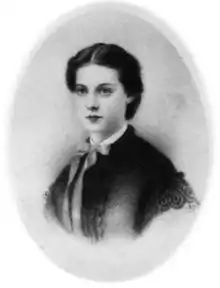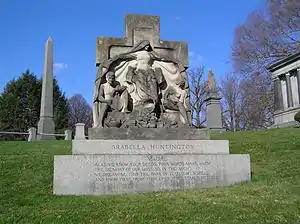Arabella Huntington
Arabella Huntington (1850–1924) was a philanthropist, the second wife of American railway tycoon and industrialist Collis P. Huntington, and then the second wife of Henry E. Huntington. Huntington was once known as the richest woman in America, and as the force behind the art collection that is housed at the Huntington Library.
Arabella Huntington | |
|---|---|
 Arabella Huntington | |
| Born | 1851 Richmond, Virginia |
| Died | 1924 |
| Burial place | Huntington Library's Mausoleum |
| Nationality | American |
| Other names | Arabella Duval Yarrington "Bell" Huntington |
| Occupation | Philanthropist |
| Known for | Second wife of American railway tycoon and industrialist Collis P. Huntington, and then the second wife of Henry E. Huntington |
| Spouse(s) | Collis Potter Huntington, Henry E. Huntington |
| Children | 1 |
| Relatives | Archer Milton Huntington (son) |
Biography

Arabella Huntington was the second wife of Collis P. Huntington. After his death, she married his nephew Henry E. Huntington, who was also a railway magnate and the founder of the Huntington Library, Art Museum and Botanical Gardens, in San Marino, California. She had a son, Archer Milton Huntington.
Compared to her family, information about Arabella is scarce. Arabella Duval Yarrington was apparently born in 1850 or 1851, probably in Richmond, Virginia (see Wark, p. 312). In the 1921 passenger list for the ship Aquitania, sailing from Cherbourg to New York, Arabella identified herself as being born in Mobile, Alabama on February 9, 1851.[1] Her first husband was a Mr. Worsham, of New York, who died shortly after they were married, leaving her with a young son, named Archer (some other sources have suggested that they were not actually married, but that she was his mistress).[2] (It has also been suggested that Archer's father was actually Collis Huntington, who legally adopted the boy when he was a teenager.).[2] In 1877 she was able to purchase some property in New York, which was later sold to John D. Rockefeller.[2] She married Collis Huntington in 1884, in San Francisco, California, and was left a widow a second time when he died in 1900.
Huntington Fund for Cancer Research
In 1902 Huntington gave $100,000 to General Memorial Hospital in memory of her husband to establish the first cancer research fund in the country, the Huntington Fund for Cancer Research. The hospital would become the Memorial Sloan-Kettering Cancer Center in New York.[3][4]
In 1913 she married Henry Huntington. They were together until her death in 1924, and both are buried on the grounds of the Huntington Library. There is also a memorial to Arabella in the west wing of the Huntington Library building, which was dedicated in 1927, the year of Henry's death.
Art collection
Throughout her life, Arabella was a collector of art, jewelry, antiques, and other luxury items. Her particular interests were in old masters, Medieval and Renaissance devotional images, and Louis XIV-Louis XV furniture and decorative arts. At her death, her entire fortune and collections went to her son Archer, who donated many of her paintings to the Metropolitan Museum of Art in New York City. These included two Rembrandts, a Vermeer, and several hundred other paintings, most of which had belonged to her husband Collis. The majority of the contents of her primary residence, including most of the artwork, on W. 57th St., were sent to auction. Many of the family's other belongings, including clothing, furniture, tapestries, and porcelain, were bequeathed to other institutions including Yale University in New Haven, Connecticut and the California Palace of the Legion of Honor art museum in San Francisco. Some are located within the collections of the Huntington Library itself, and these formed the basis of an exhibition about Arabella in the Spring of 2006 entitled The Belle of San Marino.[5] Only the small collection of Medieval and Renaissance paintings at the Huntington Library were in Arabella's own collection. They were purchased by Henry Huntington after her death from an auction set up by her son, Archer. The remainder of the objects in the 'Arabella Memorial Collection' at the Huntington were purchased after her death by Henry Huntington and are only representational of the objects she formerly owned, not the actual objects themselves.[6]
Personal life
Archer M. Huntington
Huntington's son Archer M. Huntington shared her love for art and culture. He was a great friend of non-profit organizations, especially museums. He was also one of the world's leading experts on Spanish poetry and was the founder of the Hispanic Society of America in New York City.
Death
Huntington died in New York City on September 16, 1924. Huntington is buried at the Huntington Library's Mausoleum in San Marino, California.[7]
See also
References
- "List of United States Citizens (for the Immigration Authorities)", S.S. Aquitania sailing from Cherbourg 15 Oct 1921 Arriving at New York 21 Oct 1921, Available via Ancestry.com
- Bennett, Shelley M. (1 May 2013). The Art of Wealth: The Huntingtons in the Gilded Age. San Marino, CA: Huntington Library Press. p. 350. ISBN 978-0-87328-253-6.
- "Historical Timeline". Memorial Sloan-Kettering Cancer Center. Archived from the original on 2014-07-28. Retrieved 25 June 2014.
- Arabella Archived September 26, 2006, at the Wayback Machine)
- Watters, Sam (14 May 2011). "Lost L.A.: Huntington's private tribute to wife Arabella". Los Angeles Times. Archived from the original on 2014-04-29. Retrieved 28 April 2014.
- "Arabella Duval "Bell" Yarrington Huntington". Find a Grave. Ancestry.com. Retrieved October 1, 2019.
Additional sources
- Robert W. Wark. "Arabella Huntington and the Beginnings of the Art Collection." The Founding of the Henry E. Huntington Library and Art Gallery. San Marino, CA: Huntington Library, 1969.
- Wilson. The Mauseoleum of Henry and Arabella Huntington. Berkeley, CA: University of California Press, 2005.
External links
- "Arabella Huntington". Find a Grave. Retrieved September 19, 2010.